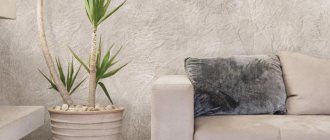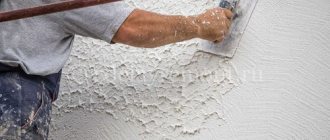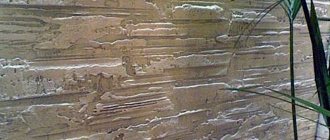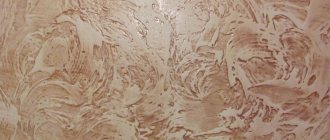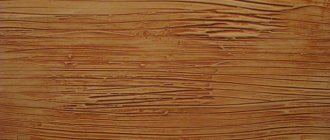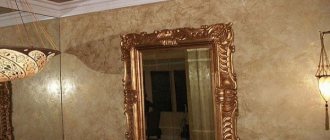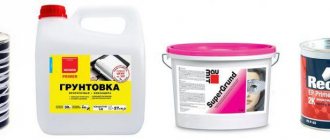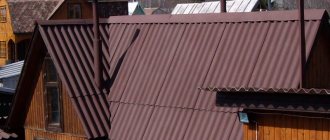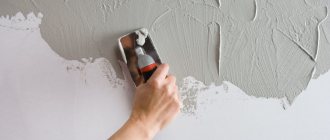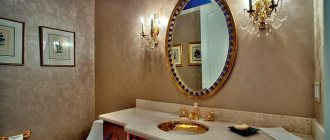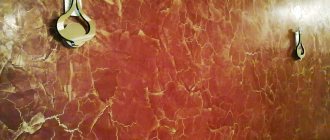We are all different: some are conservatives who do not approve of change and are difficult to encourage, while others are innovators who always need to change something and rush somewhere. Our attitude to change is manifested in any area: be it new housing conditions or major renovations. We have the same right to classify ourselves as one or another category of people, but you must agree that development still occurs through innovative ideas. And in this publication we will describe a not advanced, but very original way of finishing walls - wet silk plaster.
Characteristics of decorative plaster silk
The base material and adhesive component is acrylic. The mass is similar in consistency to paste. When decorating the walls, they look like stretched fabric.
The “liveness” of the interior is given by its ability to create play of shades with skillful lighting or viewing from different angles. Because of this effect, the mixture is called wet silk.
Its composition is in many ways similar to “Venetian”, but their characteristic difference is the finishing: Venetian plaster is covered with protective wax and polished, while silk remains matte.
Compound
Transparent acrylic and fibers play a special role in imitation of silk fabric. The polymer acts as a binder and creates a layer. Through it, light, refracted, falls on the fibers, which give texture to the material. So, wet silk decorative plaster consists of:
- acrylic;
- cellulose;
- polyester;
- from silk fibers;
- cotton
Some manufacturers suggest using glitter, mother-of-pearl or non-ferrous metal powder to make the composition more decorative. Inclusions are added as a separate component. On sale you will find colored plaster or “kohler”.
Features of preparation.
More specifically about each type of wall:
- Concrete. These walls have a high penetration rate. If you cover them with ten layers of paint, in the end there is no guarantee of obtaining the desired effect. In this case, it is rational to use pre-putty mixtures; at the same time, you can carry out training before decorative finishing. After applying the primary putty, painting is allowed; it is better to use it in white or to match the color scheme.
- Plastered walls. It is very important here to ensure that the layer does not have flaking areas. If they are detected, it is rational to clean the surface and apply a strengthening compound, for example, a primer or impregnation.
Please note that you need to protect yourself from surprises in the form of stains and stains, which may very likely be on the walls. To do this, before applying wet silk plaster, you should treat the surface with paint (oil, alkyd). You can also use other paint and varnish products, but it is better to first “make friends” the mixture with the selected product on a small area of the surface, since the reaction between them can be unpredictable.
- Drywall. Today it is very widely used if you need to quickly level a wall, in interesting interior forms and design solutions. No matter how convenient drywall is, it must be puttyed for wet silk, not just the joints, but the entire sheet.
The joints are a completely different story; they should not only be puttied, but also treated in a special way, since it is likely that they will appear under the “silk”. To do this, they need to be covered with a layer of white paint, having first mixed it with PVA glue. Ratio: 3 to 1. Also note that you need to deepen the hardware well, covering them with putty, as they can significantly spoil the appearance and leave rusty spots.
- Tree. This means that the surfaces are covered with chipboard, MDF or moisture-resistant plywood. Before applying the silk surface, they must be puttied with special mixtures and walked over them with a primer.
- Metal. This refers to sections of pipes that protrude, fittings, air ducts, etc. First of all, they must be coated with nitro enamel or oil paint. And only then apply decorative plaster.
Advantages and disadvantages of silk coating
Decorative plasters from different manufacturers have differences in price and components, but they will combine the quality characteristics of the material:
- ease of use in rooms with curved surfaces;
- no joints, seams, pattern adjustment, seamless coating;
- aesthetic appearance;
- creates a “breathable” air-permeable coating;
- Thanks to the plasticizers in the composition, the finish does not deform or break. Suitable for use in new buildings;
- does not fade in the sun;
- has antistatic properties;
- does not emit harmful fumes, can be used in a children's room.
There are much fewer disadvantages of decorative finishing and they are mainly related to the cost of the material.
- High hygroscopicity does not allow the material to be used in the bathroom and kitchen interior.
- Please note that silk actively absorbs odors.
Making different movements with a trowel or sponge will give you different effects.
Features of the material.
Silk decorative plaster has important features that set it apart from other similar products. So, taking into account its color scheme, it is quite possible to create a unique interior, turning all your fantasies into a real look. Its shades can range from light, barely noticeable ones, which favorably emphasize the tenderness and lightness of the room, to rich, deep colors. In this way, you can play with the mood of the person who will live in a house with such decoration. Also, particles of natural materials will give the room a unique sparkling effect.
An important property is also the ability to change color in different lighting conditions. Other coatings do not have these properties. Having chosen to decorate a room with such a coating, try to play with light - it will be a great sight.
Required Tools
For work you need to prepare:
- putty knife;
- trowel or soft grater;
- container and roller for primer;
- grout washer.
Also, do not forget about materials for preliminary preparation of walls: putty, primer and paint.
Using a spatula apply the composition to the trowel
Using a trowel, apply the composition to the wall and create patterns.
Preparing the mixture
You can prepare silk plaster with your own hands, in the literal sense of the word.
For this work you will need a container, water and the mixture itself. The preparation steps are as follows:
- To create a solution of silk plaster, you will need to heat the water to 35 - 40 degrees. What is needed is warm water, since cold water will not be able to dissolve the adhesive components, and hot water will lead to the loss of the properties of the mixture. First, pour the glitter into the container, mix thoroughly, and then after 5–10 minutes add the rest.
- Mix the plaster only with your hands! Therefore, this process can take a long time. To protect your hands, you must wear high rubber gloves. As soon as the solution acquires a homogeneous consistency, it is left for 20 minutes to “rest”.
As soon as the solution is ready, you can begin plastering the walls.
The processing itself looks like this:
- With gloved hands, you take a lump of the mixture and press it against the wall. It can also be applied using a trowel. The tool is used to smooth the solution, starting from the middle towards the edges. The layer thickness should be approximately 0.2 mm, otherwise the mixture consumption per square meter will increase.
- To handle corners, use a special narrow spatula. To process the ceilings you will need to install scaffolding.
- If flaws occur, they must be immediately eliminated with a spatula, and new plaster must be applied to the area.
- When you want to create a drawing or pattern, in addition to the material you will also need a filmoscope and a stencil. The projected image is outlined with a pencil on the “bare” wall, and you can immediately mark which colors are needed and in which areas. Plaster is applied in the same way as when treating the entire wall in one tone. If necessary, use a spatula to adjust the boundaries of the pattern or design.
If you want to add effect to the interior, it is recommended to light the doors or stairs (if the renovation is being carried out in a private house). With the help of a light accent, the texture of silk putty will sparkle with new colors. Therefore, you can not decorate the entire room, but only certain areas.
Primer
Decorative plaster is applied to a flat surface; this requires wall preparation. The process looks like this step by step:
- Before priming, the surface is freed from old materials such as paint, whitewash, wallpaper.
- Tap the walls, widen the cracks, remove loose parts of the former plaster.
- Seal all cracks and holes with putty.
- Areas with rust stains, areas affected by mold or fungus are cleaned and treated with anti-corrosion and fungicidal agents.
- Start leveling the walls with starting plaster.
- After the base has dried, it is necessary to smooth out any rough edges and remove dust from the surface.
- The next step is to apply primer paint to the walls. It would be correct to choose it to match the wet silk, for which it will serve as a base. The paint is applied in 2 layers.
To prevent the white plaster layer from being exposed during the technique, wet silk is applied in two layers
How to apply silk plaster
The application technology depends on the type of mixture chosen and the desired effect. Despite the different techniques, the main steps are always the same. It is important that decorative silk plaster must be applied to the wall correctly. In this case, you will get a strong, durable coating that will delight the owner throughout its entire lifespan.
How to apply, step-by-step technology:
- Preparation. We have already described this stage in detail in the previous section of the article.
- Preparation. Silk mixture for interior decoration is most often sold in a ready-made state; if you suddenly encounter a dry mixture, strictly follow the manufacturer’s instructions. Please note that such compositions require time after mixing until complete readiness is achieved.
- Base coat. This is an important step and can be accomplished in several ways. The first way is to apply the same composition using a large trowel, without creating any patterns, and let it dry. The second method is application using a regular roller. The third method is to use paint as a base layer, which is applied with a roller. You can read what material is used to perform this stage in the manufacturer's instructions. Most often it is recommended to use the same composition.
- Application of silk plaster. The mixture is applied with a trowel; its size is selected depending on the pattern you want to achieve. After partial drying, they pass over the surface with a trowel again, creating the desired texture.
Start working from the corner. Do not treat the entire surface at once, work in sections of 1.5 - 2 m2. The edges of the treated area should not be smooth, otherwise later you will see the joints of the layers.
In hard-to-reach places, use special small tools. If there are such places, make sure to purchase the tool in advance.
Video. How to apply silk plaster.
How to Apply Wet Silk to a Wall or Ceiling
After the surface is completely dry, start working with decorative plaster.
Application in one layer
Using a spatula, the material is applied to the trowel. Press the tool with its free edge to the surface and, having set the required angle, move it along the wall.
The material is transferred to the wall in a thin layer.
Do not forget that its thickness should not be greater than the size of solid inclusions. The next stroke begins, slightly extending beyond the border of the previous one.
If you intend to apply only one layer, then at this finishing stage, carefully polish the material using a washer or create the intended relief on a wet surface using auxiliary tools. If this layer is followed by a second, then the mixture is applied carefully, leaving no marks from the edge of the trowel.
Application in two layers
The second layer is applied after 6-8 hours. It should be lighter than the first one. The technique of applying decorative plaster with a second layer involves small movements in the opposite direction from the first. This allows you to create a “smoothed velvet” effect. To give the surface a certain pattern, use a variety of movements: waves, zigzags, circles, herringbones. At the end of the work, the base is polished with a float or washer.
The second layer can be applied with a thin layer of sea sponge
Forming a drawing using different techniques
The visual perception of the finished repair depends not only on the type of finishing material and its color, but also on how the craftsman will perform the work. The chosen application technique creates small nuances on which the resulting effect depends. In any case, the surface will look like it is covered with fabric, but some differences in the pattern are formed precisely by the method of application, and not by the characteristics of the material.
Smooth silk
photo from the site https://etotdom.com/
A classic technique that creates areas with different light refractive abilities, typical of a fabric prototype. If you decide to repair it yourself, the algorithm of actions will be as follows:
- Padding. It's best to apply a couple of coats to ensure there is sufficient adhesion over the entire area. Dry the primer according to the manufacturer's recommendations - from 1 to 4 hours.
- Base layer. Apply using a velor roller evenly over the entire surface. Drying time is from 2 to 4 hours. The base coat can be taken either the same color as the main one, or a little darker.
- The first layer of wet silk. Here we need a Venetian trowel. With its help, a uniform coating is formed over the entire area. The first layer will take about 8 hours to dry.
- Second layer. It is better to do this with a round plastic trowel, but a Venetian trowel will also work. The second layer is applied with short multidirectional strokes, after which it is smoothed out with even, without rounding, movements in different directions.
photo from the site https://stroyartdecor.com.ua/
Wet silk
photo from the site https://ds-faktura.ru/
Light fabric, when wet, changes its appearance, laying down in heavy sheets, and instead of flowing uniform tints we see a soft pattern with blurred contours. To get this effect, you need to do the following:
- Surface priming. Make sure that the primer saturates the coating well, otherwise the result of your efforts may soon peel off and crack.
- Base layer. Sometimes online you can find recommendations to use decorative plaster itself as the first layer, but manufacturers do not recommend deviating from the technology and produce a separate type of material for the base coat.
- A layer of silk plaster. You should work with a Venetian trowel, consistently covering an area of the wall of no more than 2 m², and leaving a torn edge, which is smoothed out when processing the adjacent area.
- Second layer of liquid silk. Apply using a round plastic trowel using smoothing movements in a circle or in a figure eight shape. Light pressure ensures the formation of curls of different directions and sizes.
photo from the site https://www.decor-inn.com.ua/
Crinkled silk effect: description of technology
There are many ways to create an imitation of crushed silk. Let's describe the most popular of them:
- We carry out all stages of interior finishing before applying the second layer;
- using a trowel, throw on enough material to “unscrew” a curl from it using a washer, perform a circular motion with light pressure;
- repeat the movement until the entire surface has been treated;
- proceed to the polishing stage: using the same circular movements of the washer, smooth out the applied pattern.
Further in the video you can clearly see the technique:
Video master class effect of crinkled silk
Plaster application technique
If you have chosen this particular decorative product, then all that remains is to calculate and purchase the required quantity and move on to the most interesting part - applying it to the walls. Usually, the package with the dry mixture contains instructions that will make it easier for you to use this mixture.
But usually the instructions for preparing the mixture always remain the same:
- prepare a convenient container, such as a basin;
- pour into the container as much water as indicated on the package;
- add the glitter that comes with the plaster and stir thoroughly;
- Now you can add the main mixture itself and mix it thoroughly.
The composition is ready for use, and you can begin applying it immediately. Your actions will look like this:
- Primer. First prepare the base - this is necessary for better adhesion of the plaster to the working surface. Use an acrylic primer designed specifically for decorative compounds to increase adhesion. The primer is applied with a brush or roller, whichever is more convenient for you. The entire surface is covered with an even layer. Can be applied in several layers.
- First layer. Prepare a plastic trowel; it should be narrow or medium in size. Use it to scoop up a little of the finished plaster, apply it carefully to the surface, the strokes should be chaotic, the gaps should be minimal. For the first layer, a thickness of 2 mm is sufficient.
- Second layer. You cannot create a silk effect with one layer. A second layer is required! The application technique will be no different from applying the first layer. To simplify the task of creating texture, use different rollers to apply the composition.
You can use different application techniques to achieve an interesting silk plaster texture. For example, the “droppe” technique involves applying short strokes that are directed in different directions. You will get an interesting plexus of leaves and curls. There is also the “moon” technique, where the mixture is applied in long strokes. And to achieve maximum imitation of wet silk, you need to apply layers very thinly - no more than 1 mm. With special rollers you can “draw” complex patterns and create folds on the applied “fabric”.
Despite the high cost of the material, it is very popular, because it is an excellent replacement for the usual wallpaper. With silk plaster, the interior immediately becomes more noble and majestic. And if you compare it with the usual wall coverings made of paper or vinyl, the plaster will last you much longer. It will not fade in the sun and will not begin to peel off from the walls. Therefore, if you have the opportunity and desire to create an unusual interior at home or in the office, you can safely buy this particular biologically friendly finishing material.
Flowing silk effect
Do all the work, including applying the first coat. Then apply a second layer and, after it is lightly “grabbed” with diagonal movements across the entire surface of the trowel, the mass is given the effect of flowing silk. Don't forget to clean the surface of the tool from any accumulated plaster with a damp cloth.
Flowing silk effect
Video of creating flowing silk
Composition of plaster, areas of its application
Silk decorative plaster is used on fairly smooth surfaces; small defects are acceptable: the material is plastic, so it can hide minor cracks or smooth out curvature.
Noble decoration is appropriate both in an apartment or private house, and in official institutions. The coating will complement an elegant, strict or bold extravagant interior - its appearance depends on the components.
Silk plaster includes quartz chips to form a special structure. Among the producers of such finishing materials, French and Italian factories are the leaders - this is a product in a more expensive segment. The quality of goods from Turkey and products of some domestic brands is quite acceptable.
Each consumer can choose a dry or moistened type of material. The dry type will be convenient for moving and storing. It is preferred by those who are not sure about the timing of the start of repairs.
Wet silk decorative plaster is made with your own hands from liquid and dry components, which must be mixed according to the instructions. A rich color palette, special types - for example, with the addition of glitter or crumbs - will allow any consumer to choose the right option.
How to make it yourself
On store shelves, decorative plaster can be found in the form of ready-made dry mixtures or individual components for independent preparation. To knead silk with your own hands, you will need:
- acrylic additives;
- cellulose and artificial silk fibers;
- cotton;
- polyester.
We prepare the decorative mass using the following technology:
- add decoration to dry ingredients: glitter, crumbs. If you want more decorativeness, then add sparkles; if you want texture, then add crumbs.
- If you need to color the mixture, do so with a small amount of powder. Once you are satisfied with the intensity of the color, you can add the required amount of pigment to the remaining material.
- Prepare the recommended amount of warm water in a separate container.
- Add the dry mixture to the water, thoroughly mixing the mixture with gloved hands.
- Leave the composition to swell for 10-12 hours.
The remaining composition from repair work can be stored in a tightly sealed plastic bag.
Application.
You can use this decorative plaster throughout the house, but I would like to focus on an unusual option for its use. Silk plaster - balcony, this is an unusual combination. It is rational to use it on a balcony or loggia if they are part of an apartment (a wall has been demolished). This way the balcony can fit into the room; silk plaster will help with this.
You can also use it to distinguish it as a separate zone, for example, a work or relaxation zone; for this it is advisable to use a different color or shade. It is convenient to use silk plaster for a balcony since no additional leveling is required; the finished version does not contain connecting seams or joints.
Caring for decorative coating
Silk plaster for interior decoration is easy to care for: dust and dry particles can be removed with a vacuum cleaner. If dirt requires wet cleaning, it can be carefully removed with a cloth soaked in soapy water.
If necessary, plaster with a wet silk effect can be coated with a protective varnish or wax. In this case, it will be possible to use all types of cleaning, including abrasive detergents.
Sometimes the contamination or damage to the plaster is so severe that there is no other option but to remove the area. There is nothing wrong with this: decorative plaster easily tolerates “partial” repairs. To do this, you just need to wet the damaged area of the wall and remove it with a spatula. If you don't have spare material or the color is not what you need, you can use the removed stock.
Preparation for work and material consumption
Before you begin, you need to prepare the walls for silk plaster. Although it is believed that the selected material, due to its texture, can hide some shortcomings. Still, you cannot compare the silk composition with full-fledged structural coatings that allow you to hide even severe unevenness. This means that walls should be carefully prepared for silk plaster. The surface must be leveled and covered with high-quality deep penetration soil.
Preparation stages:
- Preparation for plastering. As with any finishing, it is necessary to remove the remnants of the old or poorly adhering coating, remove dust and degrease the surface. To do this, you should use a vacuum cleaner and special chemicals.
- Leveling using cement plaster. It is used in cases where the wall has not been prepared at all or there are severe defects on it.
- Finishing putty. For final leveling and elimination of minor defects, we use putty.
- Primer. To improve adhesion, it is necessary to prime the surface. To do this, use soil, a tray, and a roller.
- Second coat of primer. If the surface is porous, it is worth applying a second layer of primer.
Decorative silk plaster is often used specifically for interior wall decoration. This means that the future appearance of your home will greatly depend on such a stage as preparation. Do not neglect the steps before the application itself, and you will greatly facilitate your subsequent work.
Tool that will come in handy:
- Hammer – to remove traces of previous finishing
- Scrapers and chisels - for the same purposes as a hammer drill
- Brush and vacuum cleaner - to remove dust and dirt
- Water with detergent - to remove traces of grease
It is better to use an industrial vacuum cleaner, because... a regular one will become clogged with dust, so cleaning it will be a problem.
When we start renovating everything, we wonder about the cost. And this is very closely related to consumption. To determine consumption, it is best to use the manufacturer's recommendations. Silk decorative plaster is not a very expensive material; its average consumption per square meter is 1 kg per layer per 3-5 m2. Laying usually takes place in 2-3 layers.
Let's calculate the consumption for a room of 18 m2. The wall area in such a room with two windows and a pair of doors will be 36 m2.
36:4=9 kg per layer.
Total: 18 kg for 2 layers.
Our online decorative plaster calculator will help you simplify the calculation.
White decorative coating wet silk costs around 2,500 rubles per 5 kg. This means that for a room of 36 m2 we will need about 10 thousand rubles.
Such figures are comparable to the cost of good wallpaper or expensive paints.
Manufacturers
The decorative mixture includes artificial or natural silk threads. The first group is produced by companies:
- "SILKOT" Japan,
- "SILCOAT" Türkiye,
- "SENIDECO" France,
- Russian
Their cost depends on the texture and composition. The second group is represented by:
- "Fujiwara Chemical Co" Japan,
- "BAYRAMLAR" Türkiye,
- “Peace to your home” Russia.
Of course, the quality of these products from these brands will be higher. The choice in favor of one manufacturer or another largely depends on the budget allocated for repairs.
Textures and composition
The texture of silk plaster depends on the type of application, the density of the composition and additional inclusions, as well as consistency. In some cases it is relatively smooth, in others it is velvety. The smoothness of the surface is due to the thin fibers. In addition, the composition includes dyes and metallized pigments. The radiance effect is conveyed by interspersing mother-of-pearl microparticles into the mixture of polymer solution, due to which the coating appears voluminous. This material is made on the basis of astringent acrylic polymers and polyester threads with the addition of quartz chips, which liquid wallpaper does not have. The main components are cotton or cellulose fibers. Plasticizers increase the service life of silk plaster.
Photos of finished works
If you are not yet motivated enough to work with this type of plaster, look at the photo:
Tyutyunnikov Dmitry
Article verified by a decorative finishing specialist

